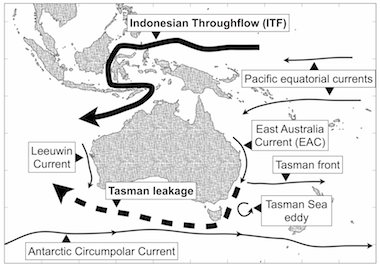Inter-ocean exchange around Australia and its relation to regional and global climate
Summary of Project for the Public Release
Movie of Tasman leakage
The circulation around Australia

PhD position open (see also the pdf letter)
In the upper ocean, water flows from the Pacific into the Indian Ocean on both the northern and southern sides of Australia. These pathways are part of a global circulation that transports large amounts of heat, carbon and nutrients around the planet and as such plays an important role in global climate. Whereas the flow north of Australia (the Indonesian Throughflow, ITF) is relatively well studied, the flow south of Australia (the Tasman leakage) is currently not well understood. The goal of this project is to reconcile these two pathways south and north of Australia and understand how they relate to each other and to regional and global climate.
In particular, the successful PhD student would be part of a team that works on analyzing the volume, heat, salt and nutrient budgets and fluxes around the South of Australia, using Lagrangian particles in high-resolution ocean models.
The PhD scholarship is tenable for a period of 3 years + 6 months extension (if granted), with the successful candidate able to mold the project to match their background, interests and expertise. Applicants should have a strong academic track record including an Honours Class I, or equivalent. Honours graduates with a strong academic track record in physics and/or mathematics are particularly encouraged to apply.
This PhD scholarship is awarded at the APA equivalent rate of $23,728 pa. Successful applicants who obtain or have recently been awarded an APA scholarship in either the current or future rounds may be awarded a $12,000 pa top-up.
International students are also encouraged but must additionally apply for a UNSW International Research Scholarship, starting Semester 2 2013, which open January 2013.
Applicants should send a full academic transcript, a short CV and an expression of interest to Bronwen Smith via [email protected].
For further information, contact Dr Erik van Sebille via [email protected]
For further details of the CCRC, its research activities and staff, see www.ccrc.unsw.edu.au